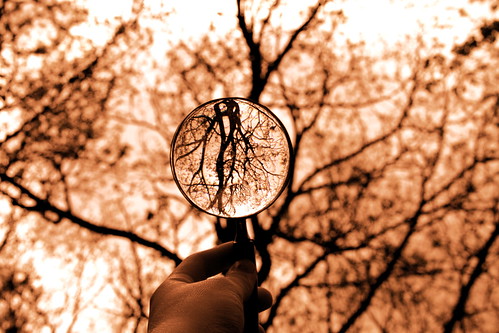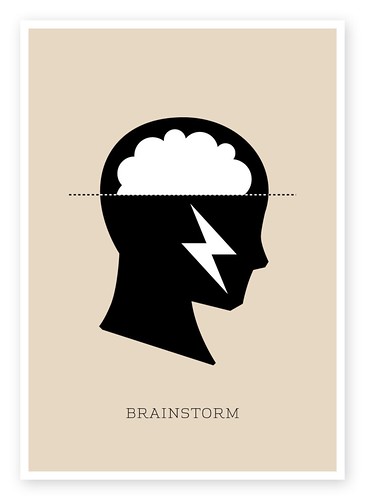This is third in a series of posts about the Seven Strands of
Creative Development: Self-Instigation, Research/Investigation,
Generation, Experimentation, Analysis, Creative Sustain, and
Collaboration. These strands were pioneered by Robert Kelly in his book Educating for Creativity. I definitely recommend you pick yourself up a copy.
Idea generation is where the possibilities come out. Generation is about growing ideas and creating possibilities. This strand is closely linked to Self-Instigation. Like instigation, the more possibilities the students come up with here, the more chances they have to find a really interesting one. There are differences between these two strands, however. In instigation, students are creating a pre-inventive structure - possibilities for a project or creation. In generation, students are moving into their inventive structure. They are finding ways to take this idea and put it into action.
 |
| Possibilities, diverging. |
This is the reason why the experimentation strand is grouped with the generation strand. In order to see if their ideas are feasible, students need to take their thoughts and put them into action. In Design Thinking, this is called "
bias towards action." What this means is you really have to try it before you'll know it will work! Prototyping an idea is an example of experimentation.
One of my students was attempting to make a stop-motion animation using a Lego minifig. It took multiple attempts to figure out how much he could move the minifig so that its movement was fluid when the film was run. Each time he tried a different rate of speed, he was actually prototyping his idea.
 |
| Experimentation. |
Generation and experimentation work together as a cycle. Generation is when students diverge with ideas and explore possibilities, and then converge on one idea to prototype it and experiment it. Students get into a rhythm of: Think --> Try --> Fail --> Fix --> Repeat
They troubleshoot when ideas don't work as planned and try new solutions to their problem.
For his 20% project, one of my students was trying to create a generator. He tested several different dowels and magnets to see what size and strength he needed. The majority of his project was spent in this cycle of diverge and converge. Ultimately, he was not able to complete his project, but spoke eloquently about this process of prototyping and going back to the drawing board when things didn't work as planned.
 |
| Convergence. |
Many students will go through this process without even realizing they're doing it. Bringing attention to the process will make the divergent-convergent pulse a more meaningful part of a creative exploration.
Edited to add:
In order to think creatively, a student needs to switch back and forth between divergent thinking (exploring the possibilities) and convergent thinking (settling on one idea, or combining several ideas for a route to pursue). An analogy is Open and Closed thinking. Divergent is Open (looking for options) and Convergent is closed (choosing one path).
The thing that's important about this is that to sustain creativity for a long period of time, a pulse should emerge between divergent and convergent thinking.
To put it in practical terms, here's an example:
In 20% time, a student wants to design a robotic machine.
First, she
diverges when she thinks of all the different things her car could do. It could go forward, it could go backwards, it could have a "hand" to pick things up, it could use sensors to avoid driving over certain colours, etc.
So then she
converges She decides she wants it to drive forward, have a hand to pick things up, and be able to sense the red blocks she wants it to pick up.
So she moves to prototyping. She programs her robot to drive forward, then tests it. It works.
She adds the robotic arm. She tests it again. The weight of the arm causes the robot to fall over.
Now she's tasked to fix her design. She goes back to
diverging. She thinks of how she might fix her design flaw. She thinks she could make the base of the robot heavier, or she could make the hand lighter, or she could scrap the arm, and try something different.
She
converges when she tries to add weight to the bottom of the robot by adding more wheels.
She tests it. It still falls.
Time to
diverge again. She redesigns her arm so it uses less parts. She tests it. The robot doesn't fall over.
She will repeat this process through her attempt to program a sensor that would sense the colour red, and cause the arm to reach and pick it up. This problem-solution, open-closed pulse is what drives her to sustain this creative project.
In explaining this to kids, I think the Think --> Try --> Fail --> Fix --> Repeat explanation would make sense to kids. Just making them understand that their journey to find a solution is not and
should not be a smooth, straightforward one would be an important message for kids to know.
If they don't have to go back and try something over, they're doing it wrong! If this happens, they're converging too much, and aren't opening new possibilities. If they converge too much, their creative thinking is limited and they're shutting down potentially great ideas. One of the pitfalls students can get into when they're doing creative work is choosing a path that's too easy. They need to know that creative work is rigorous, and that by diverging, they are opening themselves up to great ideas. But they still need to converge sometime! We all know those creative people who have amazing ideas but never act on them? They can't converge. Converging is needed to push work forward and create something tangible.




















